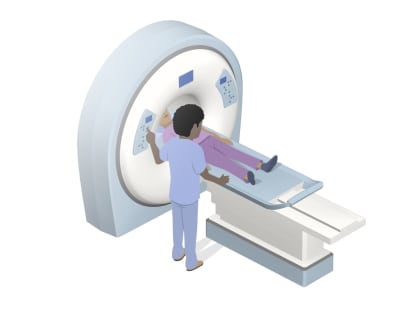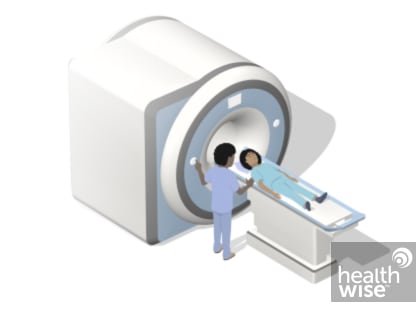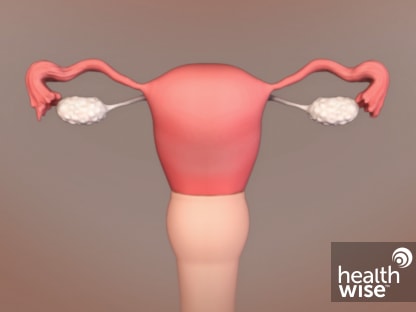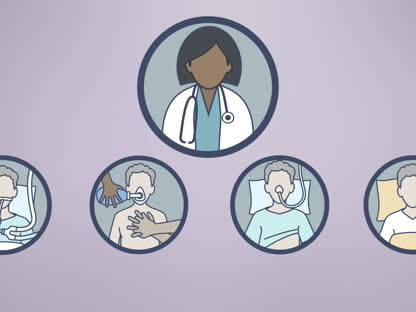Cervical Cancer
Condition Basics
What is cervical cancer?
Cervical cancer occurs when cancer cells start growing in the tissues of the cervix, Opens dialog. The cervix is the lower part of the uterus that opens into the vagina.
What causes it?
Most cervical cancer is caused by a virus called human papillomavirus, Opens dialog, or HPV. You can get HPV by having sexual contact, Opens dialog with someone who has it. Other things may play a role in causing cervical cancer, such as having more than one sex partner or smoking cigarettes.
What are the symptoms?
Symptoms of cervical cancer may include vaginal bleeding that isn't normal, such as between menstrual periods, after sex, or after menopause. Other symptoms include pain in the lower belly or pelvis or pain during sex. There may also be abnormal vaginal discharge.
How is it diagnosed?
During a pelvic exam, you may be checked for cervical cancer by getting a Pap test or a human papillomavirus (HPV) test. If the results show abnormal cells or signs of high-risk HPV, you may need other tests. To confirm a diagnosis of cervical cancer, your doctor will take a sample of tissue (biopsy).
How is cervical cancer treated?
Treatment for cervical cancer is based on the stage, Opens dialog of the cancer and other things, such as whether you might want to become pregnant. The main treatments are surgery, radiation therapy, Opens dialog, and chemotherapy, Opens dialog. Options for advanced cancer or cancer that comes back may also include targeted therapy, Opens dialog, immunotherapy, Opens dialog, and surgery.
Health Tools help you make wise health decisions or take action to improve your health.
A screening test can find cervical cell changes that can lead to cervical cancer. Regular screening tests, such as the Pap test, almost always show these cell changes before they turn into cancer. It's important to follow up with your doctor after any abnormal test result so that abnormal cell changes can be managed. This may help prevent cervical cancer.
If you are age 26 or younger, you can get the HPV vaccine, which protects against types of HPV that cause most cases of cervical cancer. If you are age 27 to 45 and have not been vaccinated for HPV, ask your doctor if getting the vaccine is right for you.
Learn more
Symptoms of cervical cancer may include:
- Vaginal bleeding that isn't normal. This may be bleeding between menstrual periods, after sex, or after menopause.
- Pain during sex.
- Vaginal discharge that isn't normal.
The symptoms of advanced cervical cancer may include:
- Ongoing pelvic, leg, or back pain.
- Urinary problems because of a blocked kidney or ureter, Opens dialog.
- Leakage of urine or stool into the vagina. This can happen when an opening (fistula, Opens dialog) has developed between the vagina and the bladder or rectum.
Cervical cancer happens when abnormal cells on the cervix, Opens dialog grow out of control. Cervical cancer can often be successfully treated when it's found early. It is usually found at a very early stage through a screening test.
If cervical cancer isn't treated, it may spread from the cervix to the vagina. It may then spread into connective tissue around the uterus. From there it may spread to the pelvic lymph nodes, Opens dialog and other pelvic organs. Advanced-stage, Opens dialog cancer may spread to lymph nodes, to other organs in the pelvis where it can cause problems with kidney and bowel function, or to other organs in the body, such as the liver and lungs.
Cervical cancer can return, or recur, after treatment. The chance that your cancer will return depends on the stage of the initial cancer. Cancer found early is less likely to come back than cancer found at a later stage.
Call your doctor if you have:
- Unexpected bleeding between menstrual periods.
- Menstrual periods that are irregular or 1½ to 2 times longer than normal for 3 months in a row. For example, call if your periods usually last 6 days but have been lasting between 9 and 12 days for your last 3 periods.
- Severe vaginal bleeding, Opens dialog that causes you to soak 1 or 2 pads or tampons in 1 or 2 hours, or passing clots of blood from the vagina.
- Unexpected bleeding after douching or sex.
- Pain during sex.
- Abnormal vaginal discharge containing mucus that may be tinged with blood.
If you are diagnosed
If you have been diagnosed with cervical cancer, be sure to follow your doctor's instructions about calling when you have problems, new symptoms, or symptoms that get worse.
If cervical cancer is suspected, your doctor will ask about your medical history and do a physical exam. This may include a pelvic exam, Opens dialog and cervical cancer screening. For the screening test, the doctor scrapes a small sample of cells from the surface of the cervix.
You may also have other tests, including blood tests and imaging tests, such as an ultrasound, a CT scan, or an MRI.
Tests to confirm a diagnosis of cervical cancer include:
- Colposcopy and cervical biopsy.
This test can find out whether and where cancer cells are on the surface of the cervix.
- Endocervical biopsy (or curettage).
This test is done to find out whether cancer cells are in the cervical canal.
- Cone biopsy.
This type of biopsy may be done to remove cervical tissue for examination under a microscope.
Screening tests for cervical cancer
The screening tests for cervical cancer are a Pap test, Opens dialog and a human papillomavirus (HPV), Opens dialog test. A Pap test looks for changes in the cells of the cervix. Abnormal cells may be a sign of cancer. An HPV test looks for some types of HPV that can cause cancer.
Learn more
Watch
Treatment for cervical cancer is based on the stage, Opens dialog of the cancer and other things, such as whether you might want to become pregnant. The main treatments include:
- Surgery.
Most women have surgery. The most common type is hysterectomy. This removes the uterus, the cervix, and part of the vagina. Options to preserve fertility include conization (removing a wedge of tissue that contains cancer) and trachelectomy (removing the cervix and part of the vagina but leaving the uterus).
- Radiation therapy.
This therapy uses high-dose X-rays to destroy cancer cells and shrink tumors. Radiation is often used with surgery.
- Chemotherapy.
These medicines kill fast-growing cells, including cancer cells and some normal cells. Chemotherapy and radiation may be given together (chemoradiation).
If the cancer is advanced or has come back (recurrent), treatment options may also include targeted therapy, Opens dialog, immunotherapy, Opens dialog, and surgery.
Your doctor will talk with you about your options and then make a treatment plan.
Learn more
Watch
Palliative care is a type of care for people who have a serious illness. It's different from care to cure your illness, called curative treatment. Palliative care provides an extra layer of support that can improve your quality of life—not just in your body, but also in your mind and spirit. Sometimes palliative care is combined with curative treatment.
The kind of care you get depends on what you need. Your goals guide your care. You can get both palliative care and care to treat your illness. You don't have to choose one or the other.
Palliative care can help you manage symptoms, pain, or side effects from treatment. It may help you and those close to you better understand your illness, talk more openly about your feelings, or decide what treatment you want or don't want. It can also help you communicate better with your doctors, nurses, family, and friends.
End-of-life care
It can be hard to live with an illness that cannot be cured. But if your health is getting worse, you may want to make decisions about end-of-life care. Planning for the end of your life does not mean that you are giving up. It is a way to make sure that your wishes are met. Clearly stating your wishes can make it easier for your loved ones. Making plans while you are still able may also ease your mind and make your final days less stressful and more meaningful.
Learn more
Watch
Treatments for cancer can cause side effects, such as fatigue, nausea, and vomiting. Your doctor can help you find ways to manage the side effects and feel better.
Healthy habits may help your symptoms. They include eating a balanced diet and getting enough sleep and activity.
Your doctor may also give you medicines to help with certain side effects. This includes medicines to control and prevent nausea and vomiting.
If your treatment includes a hysterectomy, problems may include:
- Vaginal dryness.
Lubricants, such as Astroglide or K-Y Jelly, may help. Or talk to your doctor about a low-dose vaginal estrogen cream, ring, or tablet.
- Pain during sexual intercourse.
If your vagina was shortened during surgery, changing positions may help make sex less painful. Talk with your doctor if you have any problems during sex that you think may be related to your surgery.
Learn more
- Cancer: Controlling Cancer Pain
- Cancer: Controlling Nausea and Vomiting From Chemotherapy
- Cancer: Home Treatment for Constipation
- Cancer: Home Treatment for Diarrhea
- Cancer: Home Treatment for Fatigue
- Cancer: Home Treatment for Mouth Sores
- Cancer: Home Treatment for Pain
- Cancer: Home Treatment for Sleep Problems
- Cancer Support: Managing Stress
- Eating Well During Cancer Treatment
- Female Sexual Problems
- Hair Loss From Cancer Treatment
- Quitting Smoking
Watch
Some people use complementary therapies along with medical treatment. They may help relieve the symptoms and stress of cancer or the side effects of cancer treatment. Therapies that may be helpful include:
- Acupuncture to relieve pain and other symptoms.
- Meditation or yoga to relieve stress.
- Massage and biofeedback to reduce pain and tension.
- Breathing exercises to help you relax.
Talk with your doctor about any of these options you would like to try. And let your doctor know if you are already using any complementary therapies. They are not meant to take the place of standard medical treatment. But they may help you feel better and cope better with treatment.
Learn more
Watch
Relationships take on new importance when you're faced with cancer. Your family and friends can help support you. You may also want to look beyond those who are close to you.
- Reach out to your family and friends.
Remember that the people around you want to support you, and asking for help isn't a sign of weakness.
- Tell them how they can help.
Your friends and family want to help, but some of them may not know what to do. It may help to make a list. For example, you might ask them to:
- Run errands or pick up kids.
- Deliver meals or groceries to your home.
- Drive you to appointments.
- Go to doctor visits with you and take notes.
- Look for help from other sources.
Places to turn for support include:
- Counseling.
- Counseling can help you cope with cancer and the effect cancer is having on your life. Different types of counseling include family therapy, couples therapy, group counseling, and individual counseling.
- Your health care team.
- Your team should be supportive. Be open and honest about your fears and concerns. Your doctor can help you get the right medical treatments, including counseling.
- Spiritual or religious groups.
- These groups can provide comfort and may be able to help you find counseling or other social support services.
- Social groups.
- Social groups can help you meet new people and get involved in activities you enjoy. Focus on activities that bring you comfort, such as spending time outdoors or being with children.
- A cancer support group.
- Cancer support groups offer support and practical advice. You can hear others talk about:
- What it's like to live with cancer.
- Practical ways to manage your cancer treatment and its side effects.
- Ways to cope with your illness.
Learn more
Watch
Current as of: October 25, 2024
Author: Ignite Healthwise, LLC Staff
Clinical Review Board
All Healthwise education is reviewed by a team that includes physicians, nurses, advanced practitioners, registered dieticians, and other healthcare professionals.
Current as of: October 25, 2024
Author: Ignite Healthwise, LLC Staff
Clinical Review Board
All Healthwise education is reviewed by a team that includes physicians, nurses, advanced practitioners, registered dieticians, and other healthcare professionals.
This information does not replace the advice of a doctor. Ignite Healthwise, LLC, disclaims any warranty or liability for your use of this information. Your use of this information means that you agree to the Terms of Use. Learn how we develop our content.

























